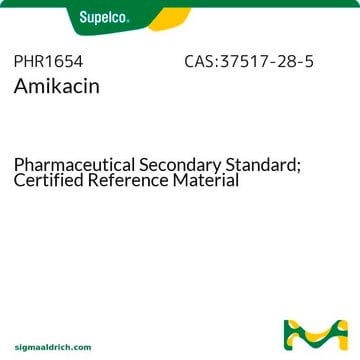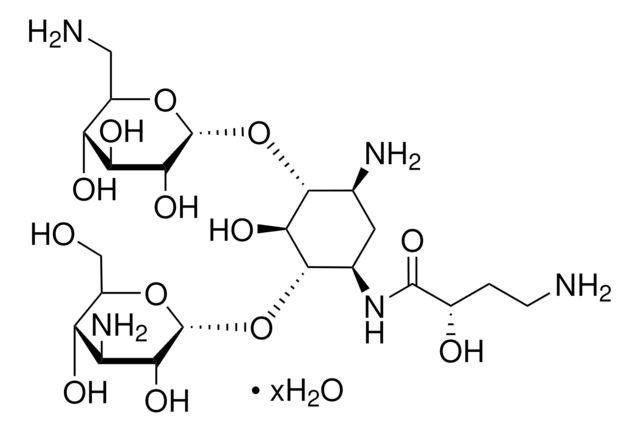SBR00066
Amikacin Ready Made Solution
25 mg/mL in water
About This Item
Recommended Products
form
liquid
Quality Level
specific activity
Antibacterial
concentration
25 mg/mL in water
antibiotic activity spectrum
Gram-negative bacteria
Gram-positive bacteria
mycobacteria
mode of action
protein synthesis | interferes
Storage temp.
2-8°C
SMILES string
O=C([C@@H](O)CCN)N[C@H]1[C@H](O[C@@H]2[C@H](O)[C@@H](N)[C@H](O)[C@@H](CO)O2)[C@@H](O)[C@H](O[C@@H]3[C@H](O)[C@@H](O)[C@H](O)[C@@H](CN)O3)[C@@H](N)C1.O=S(O)(O)=O.[F,Cl,Br,I]
InChI
1S/C22H43N5O13.H2O4S/c23-2-1-8(29)20(36)27-7-3-6(25)18(39-22-16(34)15(33)13(31)9(4-24)37-22)17(35)19(7)40-21-14(32)11(26)12(30)10(5-28)38-21;1-5(2,3)4/h6-19,21-22,28-35H,1-5,23-26H2,(H,27,36);(H2,1,2,3,4)/t6-,7+,8-,9+,10+,11-,12+,13+,14+,15-,16+,17-,18+,19-,21+,22+;/m0./s1
InChI key
HIBICIOPDUTNRR-XTHCGPPUSA-N
General description
Other Notes
signalword
Warning
hcodes
Hazard Classifications
Skin Sens. 1
Storage Class
12 - Non Combustible Liquids
wgk_germany
WGK 1
flash_point_f
Not applicable
flash_point_c
Not applicable
Certificates of Analysis (COA)
Search for Certificates of Analysis (COA) by entering the products Lot/Batch Number. Lot and Batch Numbers can be found on a product’s label following the words ‘Lot’ or ‘Batch’.
Already Own This Product?
Find documentation for the products that you have recently purchased in the Document Library.
Our team of scientists has experience in all areas of research including Life Science, Material Science, Chemical Synthesis, Chromatography, Analytical and many others.
Contact Technical Service







